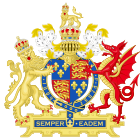Court of Exchequer Chamber

| Error From Queen's Bench Act 1584 | |
|---|---|
| Act of Parliament | |
 27 Eliz. 1. c. 8 | |
| Dates | |
| Royal assent | 14 September 1585 |
| Other legislation | |
| Repealed by | Statute Law Revision Act 1863 |
Status: Repealed | |
The Court of Exchequer Chamber was an
27 Eliz. 1
. c. 8).
The court heard references from the
first instance.[1] In cases of exceptional importance such as the Case of Mines (1568) and R v Hampden (1637)[2] twelve common law judges, four from each division below, sitting in Exchequer Chamber, might be asked to determine a point of law, the matter being referred by the court hearing the case rather than the parties.[3]
Though further appeal to the House of Lords was possible, this was rare before the nineteenth century.[1] As a rule, a judgment of the Exchequer Chamber was considered the definitive statement of the law. Certain judgments like Hampden (the case of ship money) caused political controversy.
It was superseded by the
Court of Appeal of England and Wales
.
References
- ^ a b Cornish & Clarke (1989), p. 25
- ^ 3 State Trials 825
- ^ Elton, G. R. (1960). The Tudor Constitution. Cambridge University Press.
Bibliography
- Baker, J. H. (2002). An Introduction to English Legal History (4th ed.). London: Butterworths. pp. 137–138. ISBN 0-406-93053-8.
- Cornish, W.; Clarke, G. (1989). Law and Society in England 1750-1950. London: Sweet & Maxwell. p. 25. ISBN 0421311509.

